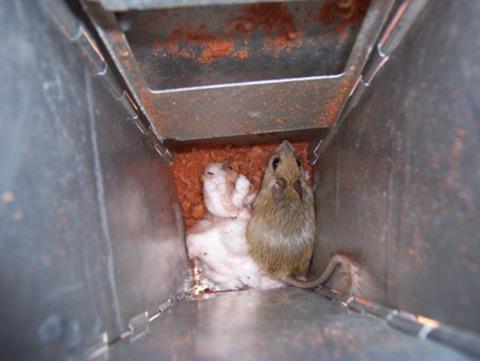Our official English website, www.x-mol.net, welcomes your
feedback! (Note: you will need to create a separate account there.)
Female reproductive suppression in an Australian arid zone rodent, the spinifex hopping mouse
Journal of Zoology ( IF 1.9 ) Pub Date : 2020-07-22 , DOI: 10.1111/jzo.12813 K. K. Berris 1 , W. G. Breed 1 , K. E. Moseby 2, 3 , S. M. Carthew 4
Journal of Zoology ( IF 1.9 ) Pub Date : 2020-07-22 , DOI: 10.1111/jzo.12813 K. K. Berris 1 , W. G. Breed 1 , K. E. Moseby 2, 3 , S. M. Carthew 4
Affiliation

|
The spinifex hopping mouse (Notomys alexis) is an Australian arid zone rodent that undergoes boom and bust population cycles in its natural environment. Most populations studied to date have been sympatric with exotic predators and introduced herbivores, likely affecting their population dynamics. Therefore, it is unclear whether high‐density populations of hopping mice are regulated by purely extrinsic factors or whether intrinsic factors are also at play. We hypothesized that reproductive suppression of female N. alexis may occur in high‐density populations as has been observed in some other rodent species. Reproductive condition of adult female N. alexis was compared between a high‐density population within the Arid Recovery reserve, where exotic predators and introduced herbivores are excluded, and a low‐density population on adjacent pastoral properties (no exclusions). Trap success was 10 times higher inside the reserve than at pastoral sites, and no adult females were observed breeding in the reserve population, despite 26 % of females at pastoral sites recorded breeding. Our results indicate that adult female N. alexis in the high‐density reserve population were reproductively suppressed, but the similar sex ratios in both populations and the high female body mass and body condition in the reserve indicated that this was not due to demographic differences between the two populations or food scarcity. Our study indicates that the ‘busts’ observed in arid zone rodent populations may be amplified due to the presence of exotic predators and/or grazing by introduced herbivores. We contend that prior to the introduction of exotic predators and introduced herbivores in Australia, the arid zone rodent N. alexis would likely have been more abundant and intrinsic population regulation through female reproductive suppression may have played a larger role in population regulation.
中文翻译:

在澳大利亚干旱区啮齿动物中的雌性生殖抑制
Spinifex跳鼠(Notomys alexis)是一种澳大利亚干旱区啮齿动物,在其自然环境中经历了种群的繁荣和萧条。迄今为止,研究的大多数人口都与外来掠食者同伴并引入食草动物,这可能会影响其种群动态。因此,尚不清楚高密度的跳跃小鼠种群是由纯粹的外在因素调控还是内在因素在起作用。我们假设高密度种群可能会抑制雌性lex。N. Alexis的繁殖,就像在其他啮齿类动物中观察到的那样。成年女性Alex。N.的生殖状况在干旱恢复保护区内的高密度种群(不包括外来食肉动物和引入的食草动物)与邻近牧区的低密度种群之间进行了比较(不排除)。保护区内部的捕捞成功率比牧区高出10倍,尽管在牧区有26%的雌性有繁殖记录,但在保护区种群中没有观察到成年雌性繁殖。我们的结果表明成年女性亚历克斯猪笼草高密度保护区人口的繁殖受到抑制,但是两个人口性别比相似,保护区女性的体重和身体状况较高,这表明这不是由于两个人口之间的人口统计学差异或食物短缺。我们的研究表明,由于存在外来食肉动物和/或引入的食草动物放牧,在干旱地区啮齿动物种群中观察到的“半身像”可能会被放大。我们认为,在引入外来捕食者和引入草食动物之前,澳大利亚的干旱地区啮齿类猪笼草可能会更加丰富,通过女性生殖抑制产生的内在种群调控可能在种群调控中发挥更大的作用。
更新日期:2020-07-22
中文翻译:

在澳大利亚干旱区啮齿动物中的雌性生殖抑制
Spinifex跳鼠(Notomys alexis)是一种澳大利亚干旱区啮齿动物,在其自然环境中经历了种群的繁荣和萧条。迄今为止,研究的大多数人口都与外来掠食者同伴并引入食草动物,这可能会影响其种群动态。因此,尚不清楚高密度的跳跃小鼠种群是由纯粹的外在因素调控还是内在因素在起作用。我们假设高密度种群可能会抑制雌性lex。N. Alexis的繁殖,就像在其他啮齿类动物中观察到的那样。成年女性Alex。N.的生殖状况在干旱恢复保护区内的高密度种群(不包括外来食肉动物和引入的食草动物)与邻近牧区的低密度种群之间进行了比较(不排除)。保护区内部的捕捞成功率比牧区高出10倍,尽管在牧区有26%的雌性有繁殖记录,但在保护区种群中没有观察到成年雌性繁殖。我们的结果表明成年女性亚历克斯猪笼草高密度保护区人口的繁殖受到抑制,但是两个人口性别比相似,保护区女性的体重和身体状况较高,这表明这不是由于两个人口之间的人口统计学差异或食物短缺。我们的研究表明,由于存在外来食肉动物和/或引入的食草动物放牧,在干旱地区啮齿动物种群中观察到的“半身像”可能会被放大。我们认为,在引入外来捕食者和引入草食动物之前,澳大利亚的干旱地区啮齿类猪笼草可能会更加丰富,通过女性生殖抑制产生的内在种群调控可能在种群调控中发挥更大的作用。











































 京公网安备 11010802027423号
京公网安备 11010802027423号